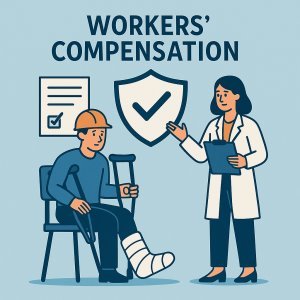
Personnel Agency Workers’ Comp Rates 2024
July 27, 2025Assault & Battery Claims: Workers’ Comp Coverage for Georgia Security Guards
July 27, 2025
In industries where hot work operations such as welding, cutting, and grinding are commonplace, maintaining stringent safety protocols is paramount. Fire watch guards play a critical role in mitigating fire hazards by continuously monitoring hot work sites for potential ignition sources.Understanding the workers’ compensation requirements associated with fire watch duties is essential for employers to ensure compliance, safeguard their workforce, and manage risks effectively.This article delves into the regulatory landscape and practical considerations surrounding fire watch guards at hot work sites, providing clarity on workers’ comp obligations and best practices for risk management.
Table of contents
- Fire Watch Guards Role and Responsibilities in Hot Work Environments
- Understanding Workers’ Compensation Coverage for Fire Watch Personnel
- Compliance Best Practices for Employers Managing Hot Work Site Risks
- Strategies to Enhance Safety and reduce Workers’ Compensation Claims
- Q&A
- Closing Remarks
Fire Watch Guards Role and Responsibilities in Hot Work Environments
In hazardous environments involving hot work operations such as welding,cutting,or grinding,fire watch guards play a crucial role in maintaining safety and preventing costly incidents. Their primary responsibilities include closely monitoring the work area for any signs of ignition or smoldering fires during and after the hot work activity. These specialists are trained to respond swiftly by using portable fire extinguishers or other suppression methods when necessary. additionally, they ensure that all hot work complies with established safety standards, including confirming that fire extinguishing equipment is readily accessible and that flammable materials are properly shielded or removed.
Key duties performed by fire watch guards include:
- Continuous surveillance during and for a specified period after the completion of hot work
- Maintaining clear communication with workers conducting hot work
- Inspecting the worksite before hot work begins to identify potential fire hazards
- documenting observed safety compliance or incidents to support workers’ compensation claims if necessary
- Promptly escalating risks to supervisory personnel or emergency responders when required
Understanding Workers’ Compensation Coverage for Fire Watch Personnel
- Hazard exposure level: Degree of risk related to the specific tasks performed.
- Duration of assignment: Length of time spent on active fire watch assignments.
- Protective equipment provision: Availability and use of fire-resistant clothing and breathing apparatus.
Employers must regularly review these factors to maintain accurate coverage and reduce liability. Below is a basic overview of typical workers’ comp classifications for fire watch personnel:
| classification Code | Description | Risk Level |
|---|---|---|
| 7380 | Fire Watch – Hot Work Sites | high |
| 7382 | Fire Watch – General Safety | Medium |
| 7384 | security Guards – Non-fire Watch | Low |
Compliance Best Practices for Employers Managing Hot Work Site risks
- Ensuring fire watch guards have completed certified safety training with a focus on hot work hazards
- Providing personal protective equipment (PPE) tailored to specific site risks
- Conducting daily safety briefings to reinforce hazard awareness and emergency response procedures
- Performing routine audits to verify firewall integrity, equipment safety, and environmental controls
| Compliance Aspect | Employer Duty | Benefit |
|---|---|---|
| Fire Watch Training | Certify guards on hot work hazards and emergency response | Reduced incident rates and claim approvals |
| Documentation | Maintain records of risk assessments and incident reports | Proof of due diligence in claims defense |
| Equipment Checks | regular inspection of fire extinguishers and alarms | Early hazard detection and fast mitigation |
Strategies to Enhance Safety and Reduce Workers’ Compensation Claims
To create a safer habitat on hot work sites, implementing proactive safety measures is essential. Employers should invest in comprehensive training programs tailored for fire watch guards and other personnel involved in hot work operations. Emphasizing the importance of hazard recognition and emergency response techniques can dramatically reduce the likelihood of workplace incidents. Additionally, regular safety audits and real-time monitoring of the site help ensure compliance with safety protocols and quickly address potential risks. Clear communication channels between management, fire watch guards, and workers play a crucial role in maintaining vigilance during high-risk tasks, preventing accidents before they escalate.
Another critical approach is integrating technology and structured safety practices to mitigate risks effectively. Utilizing digital checklists,incident tracking software,and automated alert systems enables prompt identification of unsafe conditions,fostering a culture of accountability and continuous improvement. Below is a summary table outlining key strategies and their impact on reducing workers’ compensation claims:
| Strategy | Benefit | Implementation Tip |
|---|---|---|
| Specialized Training programs | Enhances staff competency | Use scenario-based learning |
| Regular Safety Audits | Identifies unsafe practices early | Schedule monthly inspections |
| advanced Monitoring Tools | Real-time hazard detection | Implement wearable sensors |
| Clear Communication Protocols | Improves onsite coordination | Hold daily safety briefings |
Q&A
Q&A: Fire watch Guards and Hot work Sites – Workers’ Compensation Requirements Decoded
Q1: What is the role of a fire watch guard at hot work sites?
A1: A fire watch guard is responsible for monitoring areas where hot work-such as welding, cutting, or grinding-is performed. Their primary duty is to identify and suppress potential fire hazards immediately to prevent injuries, property damage, and business interruptions.
Q2: Why is workers’ compensation especially important for fire watch guards at hot work sites?
A2: Fire watch guards operate in high-risk environments involving exposure to sparks, flames, and combustible materials. This elevated risk necessitates comprehensive workers’ compensation coverage to ensure guards receive appropriate medical care and wage replacement in the event of a workplace injury.
Q3: Are fire watch guards considered separate employees, or are they classified differently under workers’ compensation policies?
A3: Typically, fire watch guards are considered employees or subcontractors, depending on the arrangement. It is critical for employers and contractors to clearly define this status for accurate workers’ compensation classification and premium calculation.
Q4: What are the key workers’ compensation requirements for employers who engage fire watch guards?
A4: Employers must ensure workers’ compensation insurance covers all personnel assigned to fire watch duties. This includes compliance with state-specific insurance mandates, proper classification codes, and notification to insurers about the nature of hot work operations.
Q5: How can employers mitigate risks and potential workers’ compensation claims related to fire watch activities?
A5: Implementing rigorous safety training, enforcing use of personal protective equipment (PPE), performing site hazard assessments, and following hot work permit procedures can significantly reduce incidents that lead to workers’ compensation claims.
Q6: Does the presence of a fire watch guard reduce workers’ compensation insurance costs?
A6: While having a fire watch guard enhances workplace safety and may lower the likelihood of fire-related incidents, insurance carriers primarily base workers’ compensation premiums on job classifications and claims history. Effective risk management, including the use of fire watch guards, can indirectly support better underwriting outcomes.
Q7: What legal obligations do employers have if a fire watch guard is injured on the job?
A7: Employers are legally obligated to provide timely workers’ compensation benefits to injured fire watch guards, including medical treatment, disability benefits, and rehabilitation support as applicable under state law. Failure to comply can result in penalties and liability exposure.
Q8: Can third-party fire watch service providers’ employees be exempt from the hiring company’s workers’ compensation coverage?
A8: Not necessarily.Responsibility for workers’ compensation coverage depends on contractual arrangements and state workers’ compensation laws. Employers should verify that third-party providers carry appropriate insurance or include indemnification clauses to manage risk effectively.
Q9: How do state regulations affect workers’ compensation requirements for fire watch guards?
A9: Workers’ compensation laws vary by state, affecting coverage mandates, classification requirements, and injury reporting procedures. Employers must consult state-specific guidelines to ensure compliance when employing fire watch guards at hot work sites.
Q10: What best practices should businesses follow to align fire watch guard operations with workers’ compensation compliance?
A10: Businesses should:
- Conduct thorough risk assessments before commencing hot work.
- Verify workers’ compensation coverage status of all fire watch personnel.
- Maintain clear documentation of roles, training, and safety protocols.
- Engage experienced insurance advisors to confirm proper policy classifications.
- Regularly audit and update safety procedures to adapt to regulatory changes.
Conclusion:
Employing fire watch guards at hot work sites is a critical safety measure that intersects directly with workers’ compensation requirements. Understanding classifications, maintaining appropriate coverage, and enforcing stringent safety practices ensure both regulatory compliance and protection of workers’ welfare.
Closing Remarks
understanding the critical role of fire watch guards in hot work environments is essential for ensuring workplace safety and compliance with workers’ compensation requirements. Employers must prioritize thorough risk assessments, enforce stringent safety protocols, and provide comprehensive training to minimize hazards and protect their workforce. By staying informed about regulatory standards and maintaining vigilant oversight, businesses can effectively mitigate liabilities, reduce the incidence of workplace injuries, and foster a culture of safety that benefits both employees and operational outcomes.
“This content was generated with the assistance of artificial intelligence. While we strive for accuracy, AI-generated content may not always reflect the most current information or professional advice. Users are encouraged to independently verify critical information and, where appropriate, consult with qualified professionals, lawyers, state statutes and regulations & NCCI rules & manuals before making decisions based on this content.







